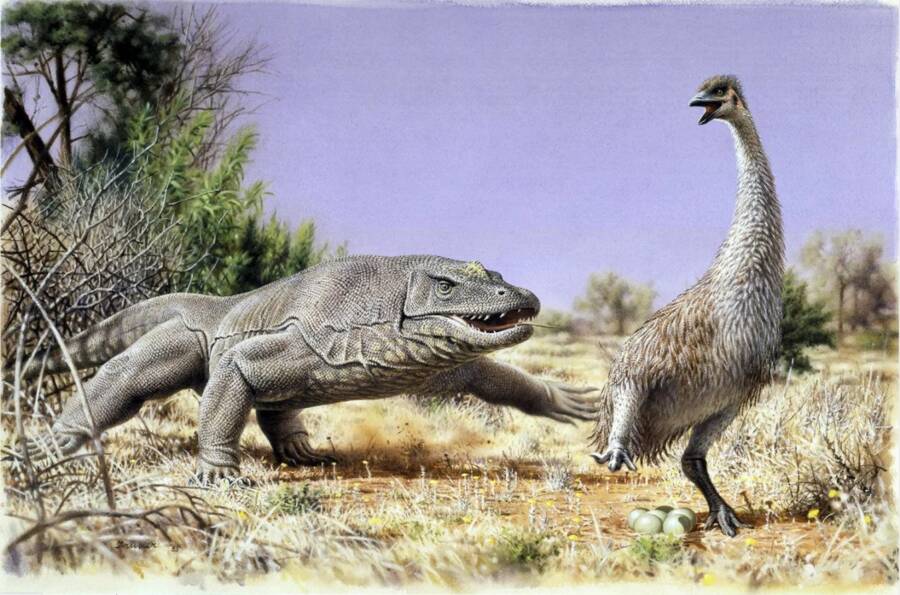Genyornis, or ‘thunder birds,’ went extinct some 47,000 years ago, shortly after humans arrived in present-day Australia.
Australian MuseumA vast flightless bird , Genyornis was a mihirungs knight a “ hell dust snort . ”
Many New - day humans like eat eggs . So did ancient the great unwashed living in Australia , and a new study indicate that they stole and eat so many ballock from huge flightless chick calledGenyornisthat they drove the small - winged wonders into quenching .
“ Eggshell fragments with unequaled suntan patterns consistent with human activity have been find at unlike places across the continent , ” Gifford Miller , a geoscientist at the University of Colorado and the co - generator of a paper about the fowl publish inProceedings of the National Academy of Sciences , tell theUniversity of Cambridge .

Australian MuseumA huge flightless bird, Genyornis was a mihirungs dubbed a “thunder bird.”
He added : “ This implies that the first humanity did not necessarily hunt these enormous doll , but did routinely raid nests and slip their giant egg for food . Overexploitation of the eggs by humans may well have contribute toGenyornisextinction . ”
Also experience as mihirunga , the birds were about six time the size of an Dromaius novaehollandiae , according toScience . Over six feet tall , and over 500 pound , they once roamed the ancient Australian continent alongside marsupial lions and gargantuan kangaroos . Then , some 47,000 year ago , they vanished .
scientist have long suspected that human being had something to do with their extinction . After all , the first homo lead off to get in Australia some 65,000 years ago , not long beforeGenyornisdied out . But it took read ancient egg to realise what role people played in the dame ’ dense demise .

Peter TruslerA depiction of a thunder bird being chased from its nest by a Megalania lizard.
agree to Science , researchers began to make a connectedness between ancient burnt eggshell , human consumption , and thunder boo in 2016 . They speculated that humans had robbed the birds ’ nest , driving the giantGenyornisto an early destruction .
“ A lot [ of plate ] had been burn down , which imply human consumption , ” Miller told Science . “ That would have been the first unattackable grounds of direct depredation . ”
But there was just one problem . Though some scientist believe that the burnt egg unquestionably belonged to thunder fowl , and thus offered validation of humans ’ role in their extinction , others argued that the bollock might have belong to a dissimilar metal money all told .
Peter TruslerA depiction of a thunder shuttlecock being chased from its nest by a Megalania lounge lizard .
Specifically , some believed that the ancient egg fragments might belong to an extinct shuttle calledProgura , or “ giant malleefowl . ” These birds were much smaller , about 11 to 15 pound , and were corresponding to big dud . The egg in question , argue those who believed that they had been lay byProgura , were too fragile to beGenyorniseggs .
“ We needed some independent elbow room to demonstrate the casing belong to to a jumbo bird , ” Miller told Science .
It was easier said than done . Scientists attempted to extract deoxyribonucleic acid from the eggs , which could have provided a quick answer to their provenance . But thousands of years in the live Australian sun made this plan unworkable .
“ The shells were too honest-to-god , and the climate is too spicy , ” Beatrice Demarchi , a University of Turin proteomics expert who helped name the eggs , state Science .
Instead , the investigator decided to try a different technique . accord to the University of Cambridge , they pull a dissimilar eccentric of “ biomolecule ” protein , which allowed them to compare the DNA sequence to living birds .
“ TheProgurawas related to today ’s megapodes , a group of birds in the galliform descent , which also hold ground - feeders such as chicken and turkeys , ” Demarchi told the University of Cambridge . “ We found that the bird responsible for for the mystery eggs emerged prior to the galliform lineage , enable us to reign out theProgurahypothesis .
“ This plump for the import that the eggs eat on by early Australians were lay byGenyornis . ”
Miller explain that early people probably did n’t nibble a fight with the Bronx cheer — they just gazump their nest . finally , humanity ate more ballock than the birds could lay .
“ It ’s quite potential humans were successful at chasing doll off the nest , ” Miller tell Science . “ The most efficient manner to cause an extinction is to capture the young . ”
That tell , interrogative sentence about the thunder birds rest . Why did such huge domestic fowl lay such small , fragile egg ? More study on that motion is necessary .
After reading about the extermination of Australia ’s thunder bird , see how ancient peopledomesticated severe cassowary skirt . Or , learn howancient Egyptians hunted crocodiles so that they could mummify them .